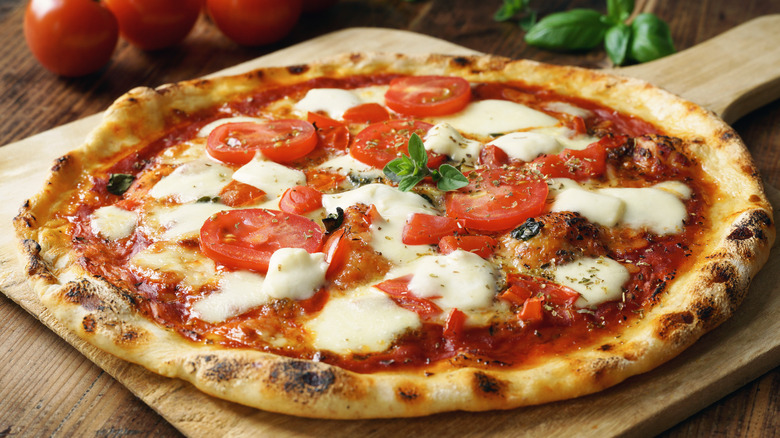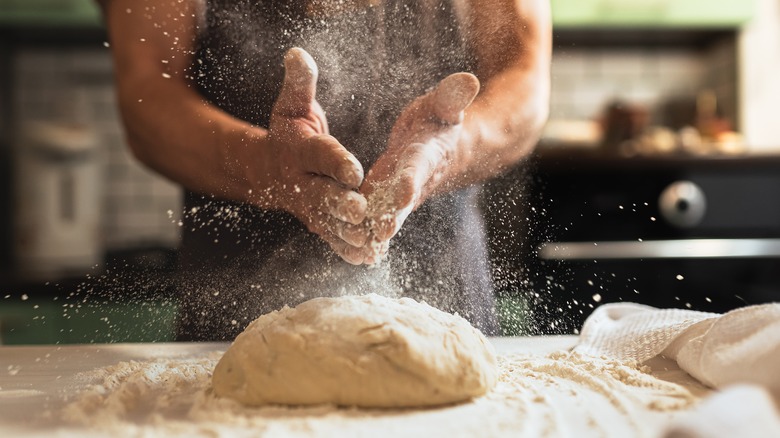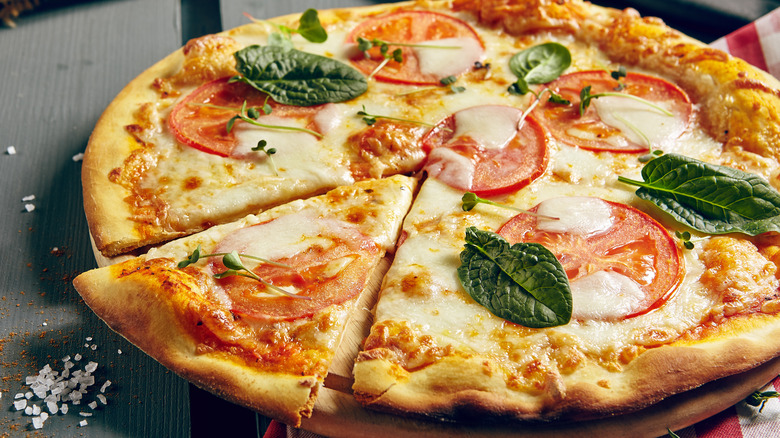The Absolute Best Kind Of Dough For A Grilled Pizza
There isn't a dish that is arguably more beloved than a pizza. In fact, more than 5 billion pizzas are sold globally, according to National Day Calendar. Pizza is believed to have originated in the 1760s in Naples, Italy (via History). The first pizza was topped with white cheese, tomatoes, and basil called pizza Margherita, named after the Italian queen who frequently noshed on the pie.
Pizza didn't make its way to the United States until the 1940s. Since then, regions created their own riff on the Italian pie dish, per History. From popular New York-style to Chicago-style, there are many varieties of pizzas that can satisfy anyone's pizza craving.
If you want the experience of a charcoal oven-baked pizza in the comfort of your home, grilled pizza is your best bet. According to Taste Atlas, grilled pizza originated in Providence, Rhode Island. Grilled pizza is cooked on — you guessed it — a grill. Per Fatherly, grilling pizza dough on a hot gas or charcoal grill can emulate the "charred, craggy" crust of a Neapolitan-style pizza, which is traditionally baked in 900-degree ovens, according to The New York Times.
Grilled pizza is characterized as a Neapolitan-style oblong pie with a thin charred crust, tomatoes, cheese, and minimal toppings (via Fatherly). Although a grill is essential in cooking a grilled pizza, having the right kind of dough is crucial to recreating a charr crust.
What is the best dough for grilled pizza
Because grilled pizza needs to be cooked on high heat, it is best to use pizza dough that can resist heat, according to Fatherly. When making pizza dough, reach for high-gluten flour. The gluten in the flour helps keep the dough structured while it is cooking on the grill and produces the crispness in crust that grilled pizza is known to have. Per Fatherly, make sure to oil the pizza dough to prevent it from sticking to the grill.
According to Healthline, gluten helps maintain moisture and shape in pizza dough and other baked goods. High-gluten flour contains up to 14% gluten, followed by bread flour with 12% to 14% gluten content. All-purpose flour contains only about 8% to 11% gluten content. Don't have access to high-gluten flour? Bread flour is suitable as well due to its high gluten content (via The Spruce Eats).
There is no official rule on what size grilled pizza should be. To get an oblong pie, you would need approximately five-ounce dough that can expand into an eight or 10-inch pizza, per Fatherly.
Minimum ingredients is key
We're not one to tell you how to top your pizza. However, traditional grill pizza is known for minimal ingredients, from the toppings down to the tomato sauce. The total cooking time is approximately two to three minutes, according to Fatherly, so you would need toppings that can be cooked in that timeframe.
Depending on the size of the pizza, you only need about two ounces of tomato sauce (via Fatherly). With the short cooking time, Fatherly suggested adding quick-melting cheese, such as Havarti or fontina. Less is more, according to Matt Hyland, founder of pizzerias Emmy Squared and Pizza Loves Emily. The high heat can turn the cheese into soup if too much is added.
If you're feeling adventurous and want to add toppings, make sure to get pre-cooked ingredients or ingredients that are safe to cook in a limited amount of time, such as "sautéed mushrooms or bell peppers, onions, bacon, and pineapple, according to The New York Times. Raw produce that is safe to consume raw — think thyme, rosemary, and sage — can also be added during and after the cooking process, per Fatherly.


